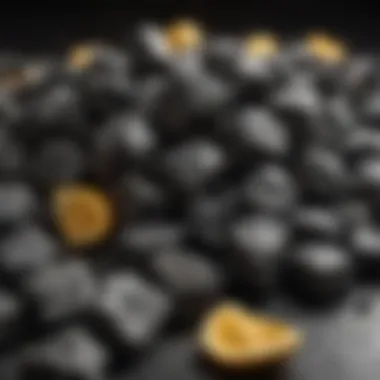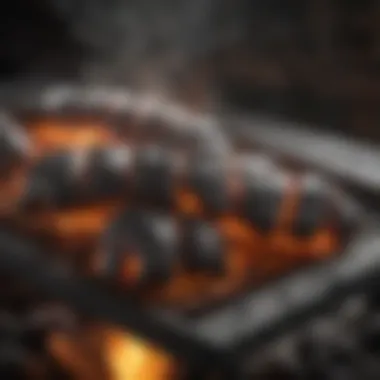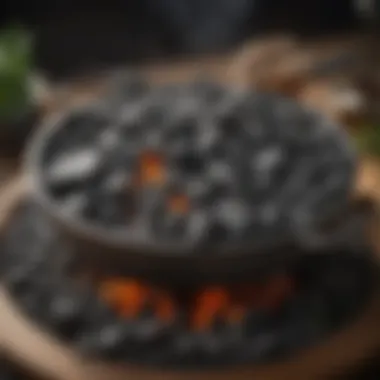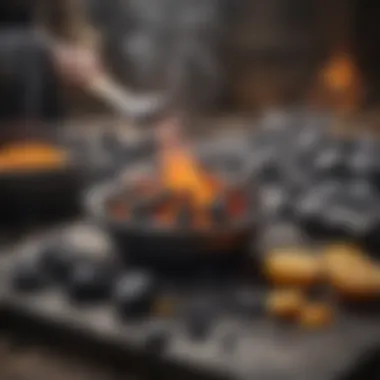Mastering Charcoal Timing for Perfect Cooking


Intro
Recipe Overview
Recipe Name
Charcoal Grilling Mastery
Description of the Dish
Charcoal grilling unlocks flavors that gas and electric cooking methods cannot replicate. It simulates a unique cooking environment, infusing food with a rich smokiness. The mastery of charcoal grilling lies in understanding when the charcoal is perfectly hot and ready to cook, ensuring that meats, vegetables, and other dishes reach their potential while remaining safe to consume.
Types of Charcoal
Different types of charcoal exist, and each has unique characteristics affecting heat and timing.
- Lump Charcoal: Made from natural hardwood, it ignites quickly and burns hotter. Typical preparation time is around 10-15 minutes.
- Charcoal Briquettes: Consistent in shape and size, these coals take longer to light, usually about 20-30 minutes. They burn longer but can produce more ash.
- Coconut Charcoal: An eco-friendly alternative, this type lights easily and reaches high temperatures. However, it may require around 15-20 minutes to be ready.
"The type of charcoal used directly influences the timing of your cooking process and the flavor of your food."
Heating Methods
The method of heating charcoal can dramatically alter its readiness and efficiency.
- Chimney Starter: A popular method, it reduces lighting time to just 10-20 minutes by utilizing airflow.
- Electric Charcoal Starter: This method also accelerates heating time but may require an electrical source surrounding the grill setup.
- Direct Flame: Using lighter fluid or matches directly can get charcoal ready within 15 minutes, but it isn’t always the safest option.
Techniques for Optimal Cooking
Adopting the right techniques ensures charcoal is used effectively to maximize flavor while prioritizing safety.
- Arranging Coals: Spread the hot coals evenly for uniform cooking.
- Zone Cooking: Create heat zones for different cooking needs; direct for searing and indirect for slower cooking.
- Monitor Temperature: Use a grill thermometer to adjust airflow and cooking time for best results.
The End
Preface to Charcoal Cooking
Charcoal cooking holds a significant place in culinary practices worldwide. It is not merely about imparting flavor; it also involves understanding how to prepare charcoal effectively. The right preparation affects not only the cooking time but also the final taste and texture of the food. Thus, mastering this area can enhance one's cooking prowess considerably.
Using charcoal introduces a depth of flavor that other cooking methods often lack. It provides a smoky essence that elevates dishes, making them more appealing. Additionally, some cooking techniques, like grilling and smoking, are closely linked to charcoal. Understanding how to prepare charcoal properly helps improve these processes.
In this section, we will clarify the essential role that charcoal plays in cooking. We will also provide an overview of its types, which helps in making informed choices for various culinary tasks. This will lay the foundation for discussing tips and techniques later in the article, aiming to assist every food lover enhance their cooking experience.
Preparing Charcoal for Cooking
Preparing charcoal properly is essential in achieving the best results in your cooking endeavors. Understanding how to prepare charcoal ensures that it burns efficiently and consistently, providing a reliable heat source. This process is not just casual; it influences the overall quality of your food, its flavor, and your cooking experience. The right approach to preparation can enhance safety as well, reducing the risk of accidents or misunderstandings during the cooking process. Therefore, it is crucial to explore the specific tools and equipment necessary for preparing charcoal effectively as well as the safety precautions needed.
Essential Tools and Equipment
When it comes to using charcoal, certain tools allow for smooth preparation and effective burning. Here are crucial tools to consider:
Chimney Starter
The chimney starter is an invaluable tool for charcoal preparation. It functions by allowing airflow through the charcoal, which promotes quicker and more efficient ignition. One of its key characteristics is its design, which typically includes a tall metal cylinder that holds charcoal above a base filled with lighter material. This tool is beneficial because it often eliminates the need for lighter fluid, which can compromise flavor and may be less safe.
A unique feature of the chimney starter is its ability to prepare a large quantity of charcoal at once, giving the cook a uniform heat for grilling. Its advantages include reducing preparation time significantly, and it is also eco-friendy due to the lesser reliance on chemical starters. However, caution is required because the metal can become extremely hot.


Grill or Smoker
The grill or smoker is another essential tool in the charcoal cooking process. These devices not only serve as cooking surfaces but also directly impact how charcoal heat is utilized, thus influencing cooking times and flavor. A critical aspect of a grill or smoker is its ability to regulate temperature, which allows for better cooking control.
Grills come in various types, from gas to charcoal, affecting their operation. While a charcoal grill provides the classic smoky flavor, a smoker offers controlled heat for longer cooking durations, ideal for dishes that require slow cooking. A unique feature of smokers is their wood chip compartments, which infuse additional flavors.
In terms of advantages, these appliances allow for versatile cooking methods. The potential disadvantages include the requirement for regular cleaning and maintenance, which may discourage some users.
Lighter Fluid
Lighter fluid is commonly used for starting charcoal. Its key characteristic is its efficiency in igniting charcoal quickly due to its flammable nature. Many cooks find it a convenient choice for ease of use, particularly when time is short.
Lighter fluid often accelerates the charcoal lighting process, making it popular among those who prioritize speed. However, it also has unique disadvantages. The chemical residues can impart flavors into food if not completely burned off. Additionally, using too much can lead to flare-ups, posing safety risks. Thus, understanding its application is essential in balancing safety and flavor in cooking.
Safety Precautions
Safety is paramount when working with charcoal. First, always operate in a well-ventilated area to prevent inhalation of smoke. Secondly, be sure to keep water or a fire extinguisher nearby in case of emergencies. Furthermore, avoid using flammable liquids other than suggested starters, and never use charcoal indoors to prevent carbon monoxide buildup. Remember to allow the grill to cool completely before handling any components. Being aware of these precautions ensures a safer cooking environment, ultimately enhancing your culinary experience.
Factors Affecting Charcoal Readiness
Charcoal readiness is central to effective cooking, particularly in grilling and smoking. Understanding the elements that impact how quickly charcoal reaches its optimal state is essential for achieving ideal cooking conditions. From the specific type of charcoal used to the environmental factors that surround the cooking area, several aspects play a role in determining the overall readiness of charcoal. A comprehensive grasp of these factors can enhance safety and improve cooking efficiency.
Type of Charcoal Used
The type of charcoal you choose is one of the most significant factors influencing its readiness. Different kinds of charcoal have unique burning characteristics. For instance, lump charcoal tends to light quickly and reach high temperatures faster than briquettes, which often provide a steadier heat over a longer period. When selecting charcoal, consider its combustion properties to align with your cooking style.
For example, if you prioritize speed and high heat for searing, lump charcoal may be your best option. In contrast, if you want to sustain a longer cook at a moderate temperature, briquettes might be more suitable. The choice of charcoal also impacts flavor; some charcoals impart a smokier taste, which can enhance the overall culinary experience.
Environmental Conditions
Environmental conditions significantly affect how charcoal burns and its readiness for cooking. Factors such as humidity levels and wind speed play crucial roles.
Humidity Levels
Humidity levels are vital to consider when preparing charcoal. High humidity can slow the ignition process by making it difficult for oxygen to circulate around the charcoal. This slower ignition can cause a longer wait for the charcoal to be fully ready.
On the other hand, moderate humidity is beneficial as it keeps the charcoal from drying out too quickly. When humidity levels are balanced, the charcoal can burn more evenly and reach optimal heat more effectively. High humidity environments can create unique challenges, such as the need for additional accelerants to help the charcoal ignite properly.
Wind Speed
Wind speed is another critical environmental factor that impacts charcoal readiness. A gentle breeze can enhance airflow, promoting faster ignition and maintaining a more consistent burn. However, strong winds can quickly disperse heat and oxygen, which could lead to an uneven burn of the charcoal.
When wind conditions are unfavorable, it may be necessary to adjust the arrangement of the charcoal or use barriers to minimize airflow disruption. This helps maintain the heat and achieve readiness within a reasonable timeframe.
Amount of Charcoal
The volume of charcoal used directly correlates with how quickly it reaches readiness. When cooking for a larger group, ensure you do not overload the grill. Overloading can create clumps that restrict airflow and increase the time required for ignition. Conversely, not having enough charcoal can lead to a rapid loss of heat, which also affects cooking efficiency.
A well-thought-out amount of charcoal, suitable for the specific cooking task, can significantly optimize the heating process, ensuring that it reaches a desirable temperature in a timely manner.
Typical Timing for Charcoal Readiness
Understanding the timing of charcoal readiness is crucial for anyone involved in cooking with charcoal. The time it takes for charcoal to ignite and reach optimal cooking temperatures affects not only the efficiency of the cooking process but also the flavor and texture of the food being prepared. Knowing the right timing helps in planning the meal, ensuring that everything is served hot and at the right moment.
Various factors influence how quickly charcoal can reach readiness, including the type of charcoal used and environmental conditions. Additionally, recognizing visual indicators can guide cooks in determining when their charcoal is at the ideal state for grilling or smoking.
General Guidelines


In general, charcoal readiness can vary based on a few standard guidelines. Typically, it takes between 15 to 30 minutes for charcoal to reach cooking temperature, depending on the type of charcoal and the setup used. Here are several key points to consider:
- Lighting method: The method used to ignite the charcoal can significantly alter timing. For example, using a chimney starter often produces faster results compared to lighter fluid.
- Quantity of charcoal: The more charcoal you use, the longer it might take to reach the desired temperature. A larger amount requires more time to heat evenly.
- Airflow: Adequate airflow is essential. Ensuring that vents are open allows oxygen to fuel the fire, promoting quicker ignition and readiness.
Charcoal Briquettes
Charcoal briquettes typically take time to ignite. On average, they require about 20 to 30 minutes to become fully ready for cooking. Briquettes are designed for a slow, steady burn, making them a good choice for extended cooking sessions. Here’s what you need to know:
- When ignited, briquettes will start with a gray ash covering, which indicates they are ready for cooking.
- If using lighter fluid, let the briquettes burn for a few minutes after they are lit, as lingering chemicals may affect flavor.
- Consider arranging briquettes into a pyramid shape for better airflow, promoting faster ignition.
Lump Charcoal
Lump charcoal ignites faster than briquettes, usually within 15 to 20 minutes. Its natural composition makes it a more efficient option for those who want to get cooking quickly. A few characteristics of lump charcoal include:
- It often produces a hotter and cleaner burn, which can enhance the flavor of grilled food.
- Look for the same ash-gray indicator; once lumps are covered in ash, they are ready for cooking.
- The size of the lumps can affect timing; larger cuts may take longer to fully ignite, so consider breaking them up if speed is a priority.
"Understanding the timing when using different types of charcoal is essential for achieving optimal results in cooking."
By mastering the timing of charcoal readiness, cooks can create delicious meals while minimizing delays. This knowledge empowers both new and experienced grillers to enhance their culinary skills and enjoy a more efficient cooking experience.
Techniques to Reduce Charcoal Preparation Time
Charcoal preparation is a vital step in cooking, especially for enthusiasts who aim for efficiency. Reducing the time it takes to prepare charcoal not only streamlines the cooking process but also enhances the overall experience. By optimizing how charcoal is arranged and considering the use of accelerants, cooks can significantly decrease waiting times while ensuring a strong and consistent heat source.
Proper Arrangement of Charcoal
The way charcoal is arranged in a grill or smoker plays a critical role in its burning efficiency. Proper arrangement affects airflow and heat distribution, which are essential for achieving optimal cooking conditions.
To arrange charcoal correctly:
- Create a Pyramid Shape: This formation allows air to circulate effectively between the pieces of charcoal. Oxygen is crucial for burning, and a good pyramid shape primes the fire.
- Leave Space for Airflow: Avoid tightly packing charcoal. Gaps are necessary for air to flow seamlessly. This air current fuels the combustion process, leading to quicker readiness.
- Utilize the Two-Zone Method: For multifaceted cooking, one zone should be hotter than the other. Pile more charcoal to one side while leaving less on the opposite side. This allows for diverse cooking techniques, including direct and indirect heat.
These adjustments directly impact the time needed for charcoal to heat, enabling quicker cooking times without compromising the flavor.
Using Accelerants
Accelerants are substances used to speed up the ignition process of charcoal. While some purists may prefer traditional methods, using a reliable accelerant can save considerable time. Here are a few considerations regarding accelerants:
- Types of Accelerants: Common options include lighter fluid and various fire starters. Lighter fluid should be used judiciously to avoid a chemical taste in food. In contrast, products like wax fire starters can provide clean heat without affecting flavor.
- Application Techniques: When using lighter fluid, apply it evenly across the charcoal and allow it to soak for a few minutes before igniting. This process leads to a more even burn and quicker ignition.
- Environment Considerations: Wind and humidity can influence the effectiveness of accelerants. A windy day may require more product due to increased evaporation of lighter fluid before it ignites. Be mindful of conditions to use the proper amount.
Using accelerants effectively can reduce preparation time significantly, allowing for a faster transition to the cooking phase.
"By optimizing both charcoal arrangement and the use of accelerants, cooks can not only reduce the time spent preparing but also achieve a more stable and intense heat for better cooking results."
Determining When Charcoal is Ready
Knowing when charcoal is ready for cooking is crucial for effective grilling and barbecuing. This step can greatly influence the cooking process and the final flavor of your food. Proper timing ensures that food is cooked evenly and thoroughly while avoiding issues such as flare-ups or undercooked meat. Mistakes in timing can lead to disappointing results, making it important to understand the signs of readiness.
Listening to your charcoal can be as essential as the cooking itself. Each type of charcoal has unique indicators, and recognizing these can assist in achieving optimal cooking conditions. The two main signifiers of readiness are visual indicators and heat emission levels, both of which will be discussed in detail.
Visual Indicators
Visual cues are among the most straightforward ways to determine if charcoal is ready for use. When you light charcoal, it undergoes a transformation that can be observed visually. Here are some key signs to look out for:
- Color Change: New charcoal starts as a dark black or gray shade. As it heats up, it turns ashen gray or white, indicating that it's ready for cooking. The ideal appearance is a consistent light gray with no visible black patches.
- Glowing Embers: When charcoal reaches the right temperature, the coal will emit a bright red or orange glow. This is another strong indicator that charcoal is hot enough to use. The brightness can indicate the intensity of the heat.
- Particle Characteristics: After the charcoal has been ignited for a sufficient time, fine ash appears on the surface. The amount of ash can help gauge the temperature range—too much may indicate overheating or the need for airflow adjustment.


These visual indicators can vary depending on the type of charcoal. For instance, briquettes may appear differently than lump charcoal. Familiarity with these indicators can greatly enhance your grilling efficiency.
Heat Emission Levels
Another critical aspect to consider is the heat emitted from the charcoal. The temperature at which charcoal burns affects cooking times and food texture.
- Temperature Measurements: Using an infrared thermometer can help gauge the temperature, but you might not always have one on hand. Instead, you can perform a simple hand test. Hold your hand about six inches above the grill. If you can hold it there for 2-4 seconds, you can expect temperatures around 350-450°F, appropriate for grilling. If it’s 1-2 seconds, the temperature is likely between 450-550°F, great for searing.
- Consistent Heat Emission: After the initial startup phase, the charcoal should emit a steady heat. If you notice fluctuating heat levels, it may be time to revisit the airflow or the amount of charcoal used. Continuous heat is key for even cooking—short bursts can lead to inconsistent results.
Understanding these indicators allows for effective management of heat and prevents overcooking or burning. Recognizing when charcoal reaches readiness is essential knowledge for any culinary enthusiast.
Combining both visual indicators and heat emissions can facilitate successful charcoal use, yielding flavorful and well-cooked dishes. By mastering these detection techniques, grilling and barbecuing can become more enjoyable and efficient processes.
Common Mistakes in Charcoal Preparation
Understanding common mistakes in charcoal preparation is crucial for achieving optimal cooking results. Often, these mistakes can lead to inefficient heating, wasted fuel, and even safety hazards. This section will analyze some typical errors to avoid, which can drastically improve your charcoal cooking endeavors.
Overloading the Grill
One frequent blunder is overloading the grill with charcoal. While it may seem intuitive to use more charcoal to heat quickly or maintain high temperatures, excess charcoal can impede airflow. This reduced airflow creates a less efficient burn, leading to uneven cooking temperatures. In extreme cases, overloading can suffocate the fire, causing it to extinguish itself.
To prevent this, consider these points:
- Use Appropriate Quantities: Monitor how much charcoal is suitable for the grill size and cooking duration. This helps maintain a stable heat.
- Space Charcoal Properly: Avoid placing the charcoal too close together. This allows air to circulate, promoting effective combustion.
- Test Heat Levels: If unsure of the right amount, light less charcoal at first and add more gradually until desired heat levels are reached.
By remaining vigilant about charcoal quantities, you can ensure a prolonged and efficient cooking session.
Neglecting Airflow
Another significant oversight is neglecting proper airflow. Charcoal needs oxygen to burn effectively. Inadequate airflow can lead to poor combustion, diminishing heat output and affecting overall cooking performance. Many users ignore this aspect and miss the importance of adjusting the grill vents to optimize air circulation.
Here are key elements to keep in mind:
- Adjust Vents Appropriately: Open vents allow more air to reach the fire. Ensure at least one vent is open during cooking for sufficient oxygen supply.
- Keep the Grill Clean: Residue buildup can block airflow. Regularly inspect and clean the grill to maintain optimal conditions.
- Position the Grill Wisely: Avoid placing the grill in a location where wind restricts airflow. Ensuring that there is no obstruction around it can enhance performance.
Proper airflow is essential for charcoal to burn effectively, impacting both heat and flavor in your food.
By addressing these common mistakes, you can enhance both safety and efficiency in charcoal preparation. An informed approach can elevate your cooking experience, making each grilling session more enjoyable and successful.
End
The conclusion of this article highlights the critical facets of charcoal preparation. It synthesizes the insights gathered throughout the various sections, aiming to solidify the reader's understanding of how timing affects the cooking process. Recognizing the nuances of charcoal types, environmental factors, and preparation techniques can greatly enhance one’s culinary experience. Each element discussed plays a vital role in ensuring both safety and optimal cooking conditions.
By being aware of the timing and readiness of charcoal, cooks can avoid frustrations that arise from either underprepared or overcooked meals. Moreover, with the right techniques, one can minimize the wait time and make the grilling or smoking process more effective.
"Effective preparation leads to superior cooking, allowing for flavor and texture to shine."
In addition to enhancing the outcome of dishes, mastering the timing in charcoal preparation encourages a more enjoyable cooking atmosphere. This reinforces the value of patience and precision in the culinary arts.
Recap of Key Points
In summary, this article covered the following essential points:
- The vital role of charcoal in culinary practices.
- Different types of charcoal, including wood charcoal and briquettes, have unique properties affecting their usage.
- Techniques to prepare charcoal efficiently, ensuring readiness in a timely manner.
- Common mistakes that can hinder the charcoal readiness like overloading the grill or neglecting airflow.
- Visual signs and indicators to determine when the charcoal is ready for cooking.
Acknowledging these aspects equips any aspiring cook with the knowledge needed to make informed decisions in charcoal preparation.
Encouragement for Proper Techniques
Getting accustomed to the proper techniques in charcoal preparation is fundamental for anyone who often cooks with it. Each step from selecting appropriate charcoal to realizing the right time to start cooking should be approached with care.
Spending time on preparation can lead to flavors that stand out. Whether you are a beginner or seasoned cook, refining your technique will help in achieving consistently better results. Remember, safety should always be a priority.
As you continue to enjoy charcoal cooking, take the insights from this article and implement them in your kitchen. Experiment with timing and techniques to discover what works best for your unique culinary style.







